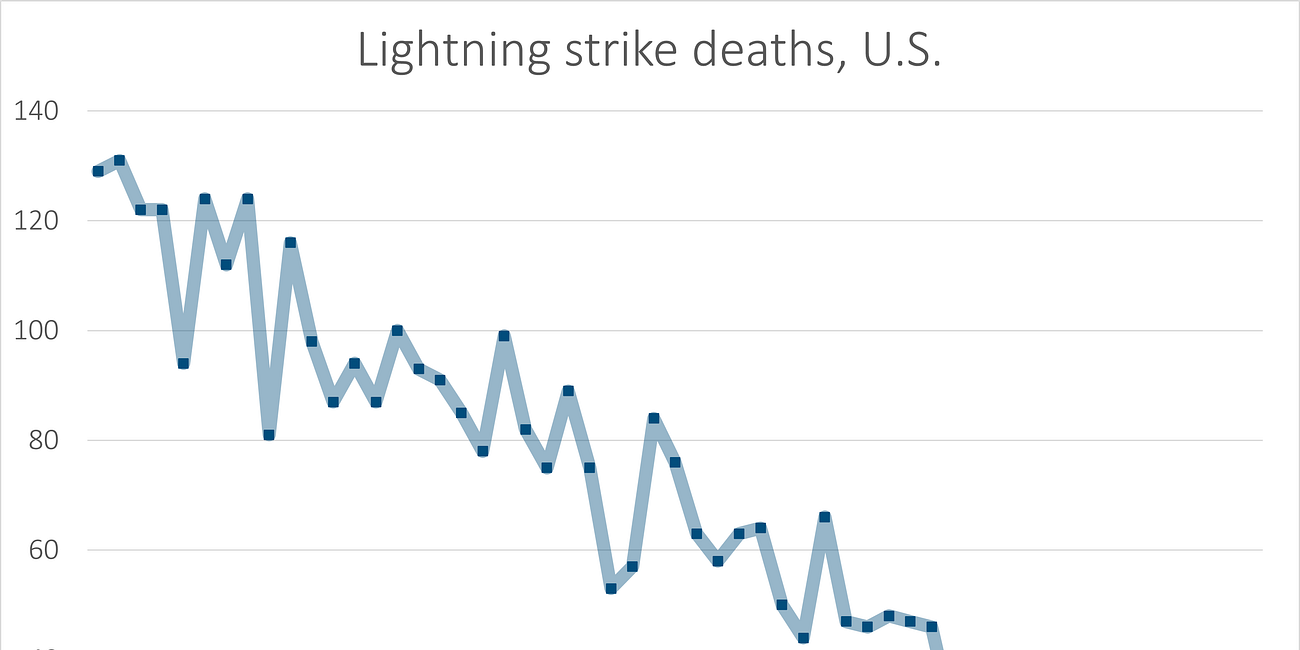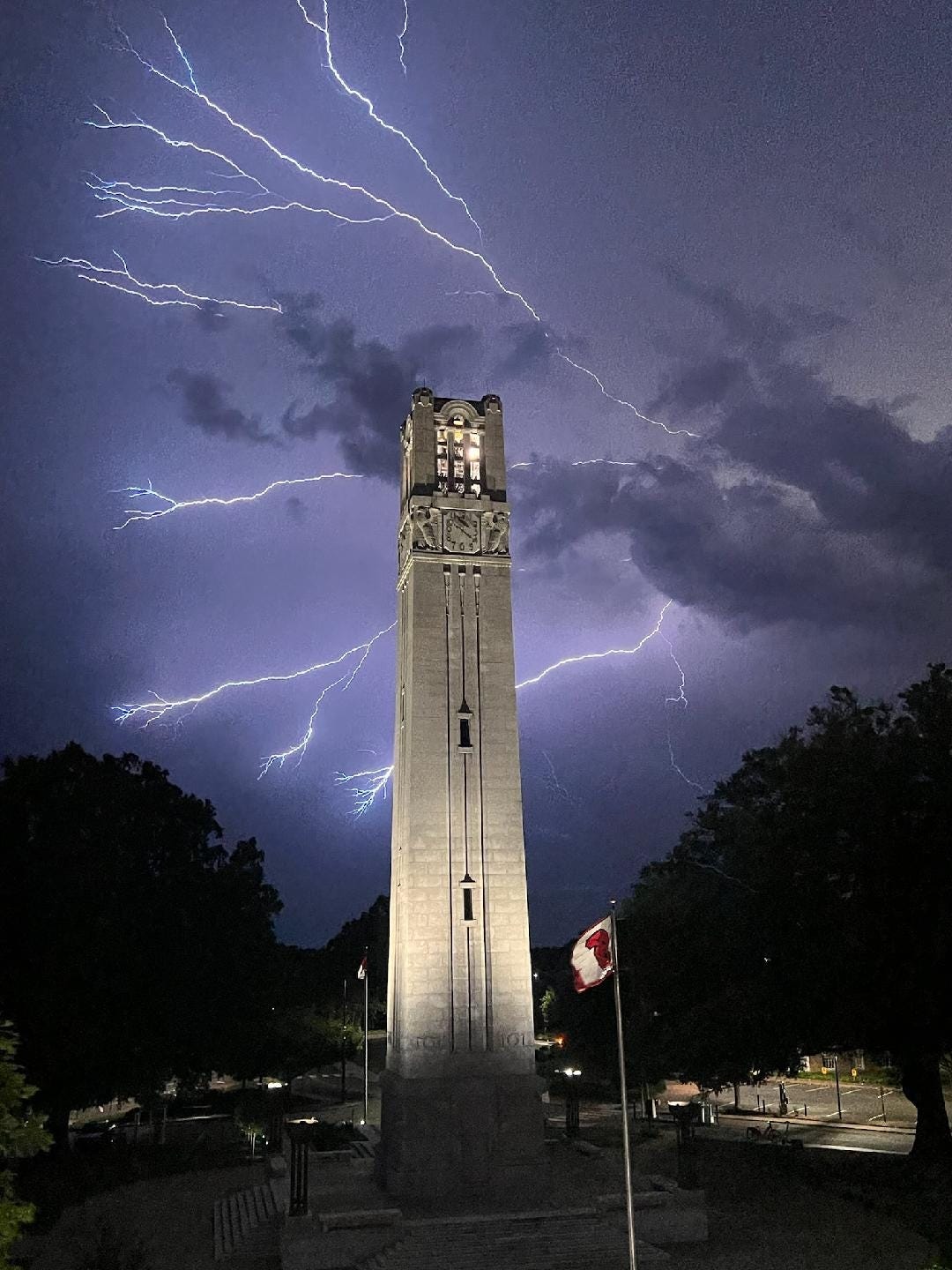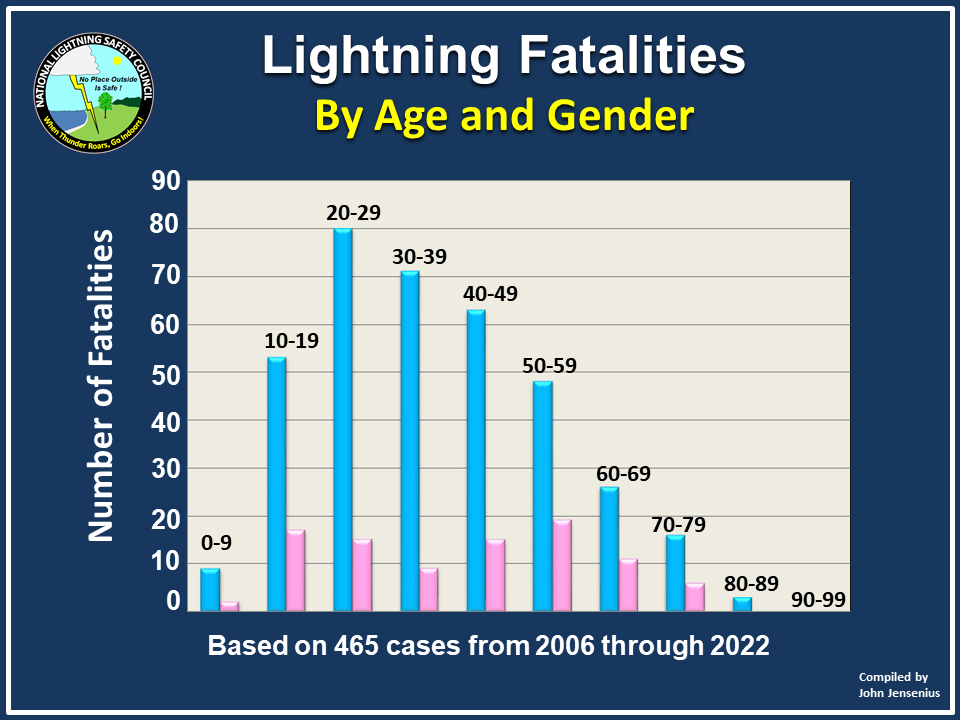Lightning Strikes Twice: Follow-up on Lightning Deaths
When thunder roars, GO INDOORS!
Back in June, I did a podcast episode on lightning strike deaths.
Lightning Strike Deaths
Listen now (28 min) | Lightning strike deaths have decreased by over 80% from 1968 to 2022! Thanks to lots of changes, but primarily because of improved weather forecasting. Alas, they still occur, as was just reported from Texas, but we can thank technological change for this benefit.
I got a lovely surprise when John Jensenius from the National Lightning Safety Council reached out to me after that episode to give me LOADS more information.
I got a chance to have a long conversation with John, so let me share some of the extra information he shared with me.
Watch Out: Most Strikes are Before the Rain Starts
I noted in my podcast that lightning deaths had been trending down for years:
I attributed it to better weather forecasting and people having smartphones to alert them to lightning storms.
However, it also requires understanding at what point one is in danger.
Just going by the front page of the National Lightning Safety Council:
NO PLACE OUTSIDE IS SAFE
when thunderstorms are in the area.WHEN THUNDER ROARS, GO INDOORS!
John mentioned to me that most people are struck before any rain begins (because, of course, most people will have sought shelter at that point).
You can be struck for up to 10 miles away from the thunderstorm itself.
Here is John Jensenius providing introductory information:
Back to the Death Stats: All About Data
I had mentioned that soon I wouldn’t be able to get the data on lightning deaths easily from CDC WONDER, because it would drop below 10 deaths per year.
Well, they keep tabs on lightning deaths… and here is a detail that John mentioned to me:
We are aware of differences between our numbers and CDC's numbers. We do our best to document every lightning fatality that we can through media reports, reports to the National Weather Service, OSHA reports, public reports provided directly to us, etc. That said, I'm sure we miss a few. We and the National Weather Service share our information so our databases typically match. [….. ] As I'm sure you know, the CDC relies on death certificates provided by medical examiners/coroners. While I assume most of these are coded accurately (possible coding errors), I am aware of one recent questionable case where the medical examiner decided to list the death as due to lightning, but our investigation (based on lightning data) did not show any lightning strikes in the immediate area. I'm also aware of two cases where we listed the death as lightning, but we were told the medical examiner did not (one heart condition, one drowning).
The issue is often the person who died is alone when they were struck — they were not able to get to shelter.
One of the reasons that the National Weather Service and the National Lightning Safety Council can keep track of weather-related deaths in such detail is that, thank goodness, such deaths are unusual nowadays.
And are pretty shocking. (Not sorry)
Weather-related deaths, the direct kind — like deaths from floods, hurricanes, direct heat and freezing deaths (for all that people want to make hay about them) — these are a very small percentage of deaths in the U.S. currently compared to all other causes. When they occur, they are bound to be reported on … if the person’s body is found.
In any case, here’s an updated graph, comparing the CDC numbers to the National Lightning Safety Council’s:
Because the National Lightning Safety Council gathers and reports information as it happens, I have a partial count for 2023, so far.
They also collect other data not on the death certificates, such as what activity the person was doing when they were struck.
Some stats on who is fatally struck by lightning
When talking with John, I, of course, guessed that golfing would be one of the top activities when people are struck by lightning.
Nope.
It’s fishing:
From 2006 through 2022, 466 people were struck and killed by lightning in the United States. Almost two thirds of the deaths occurred to people who had been enjoying outdoor leisure activities. The common belief that golfers are responsible for the greatest number of lightning deaths is shown to be a myth. During this 17-year period fishermen accounted for more than three times as many fatalities as golfers, while beach activities, boating, and camping each accounted for about twice as many deaths as golf. From 2006 to 2022, there were 40 fishing deaths, 29 beach deaths, 25 boating deaths, and 23 camping deaths. Of the sports activities, soccer and golf saw the greatest number of deaths with 13. Around the home, yard work (including mowing the lawn) accounted for 21 fatalities. For work-related activities, ranching/farming topped the list with 21 deaths.
In the record compiled, there were 466 deaths, so 8.6% of the total deaths were fishing-related.
The above comes from the executive summary from the most recent analysis done by John Jensenius. I’m going to grab a few of the graphs from his report, which you may find interesting.
Water is dangerous
I’m starting with the where. John categorized by whether it was leisure activities, daily routine, or work-related:
That gives you an idea of the level of choice involved. Given it’s leisure-related, primarily, people can choose to go do something else… but, let’s check where they are:
The issue is this: the problem with many of these situations is that people may be unable to find suitable shelter. (Golfing falls under “sports”, by the way.)
To be sure, perhaps more people fish than golf, but even without that disparity, if one were golfing, it is fairly easy to get in a golf cart and head back to the clubhouse. With fishing, depending on where you are, there may be no suitable shelter nearby if there is an unexpected storm.
I asked Jensenius what to do if you’re caught out where you can’t find shelter: the main point is to minimize your contact with the ground, which is usually how the current flows through people.
So stand on one leg and hop up and down.
Okay, that may be difficult to do, but the main thing is not to spread out on the ground, don’t stand with your feet wide apart, etc.
Science Daily: ER Physician Tells You How To Avoid A Lightning Strike And What To Do If One Occurs
The other type of strike - step potential – happens when a current traveling through the ground goes up your leg, travels through you and then goes down the other leg and back into the ground. “That is why Boy Scouts practice standing on one leg during a storm,” she explained. “They are attempting to decrease the likelihood that the current will go through them by having only one foot on the ground.”
Prevention begins by seeking cover at the start of a storm. “Lightning seems to be concentrated at the forefront of a storm,” according to Zinzuwadia, “so there tends to be a greater risk of being hit by lightning at the beginning of a storm.”
….
If you are outside during a storm, crouch down and try to touch as little of the ground as you can, Zinzuwadia suggests. “Even if you are hit by the current, the less contact there is between you and the ground, the less likely it is that all of your major organs will be hit,” she says. “It increases your chances of survival.”
Demographics of those hit
I mentioned this last time, I believe, but it’s exactly who you think: mainly younger men.
Jensenius did note the little bump up for age 50-59, which may be women in early retirement with their husbands, as well as the drop off in age 30-39, the age at which mom is like… no. I’m staying inside… the kids are NOT going outside in a thunderstorm.
Peak lightning death month: July
Lightning deaths, unsurprisingly, are seasonal:
However, day of the week doesn’t seem to have as strong a pattern:
Yes, a bit more on weekends, but if people are on vacation in July and get hit… might not be on a weekend.
Bonus graph: National Weather Service record to 1940
John Jensenius used to work at the National Weather Service before retiring, when he had started communicating weather safety, specifically lightning. So he pointed me to this page of weather fatality statistics, which reaches back to 1940.
I may revisit this data set, as it also has flood, tornado, and hurricane deaths listed…












Go indoors sounds a LOT easier than hopping (or sqatting) on 1 leg...